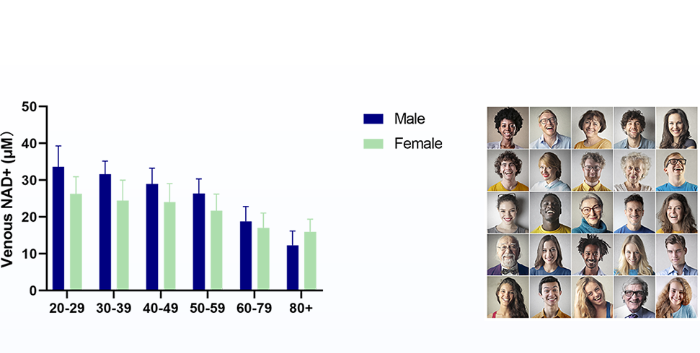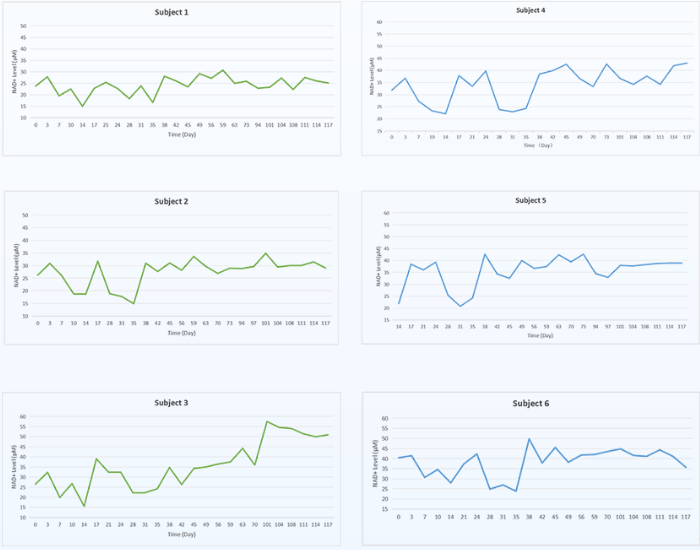
We mapped the whole blood NAD+ levels of NAD+ supplement-naive people including 75females and 67 males across different age groups. The cross-gender comparisonindicated that females have on average a lower whole blood NAD+ level (27.2 ± 10.3 μM)compared to males (32.5 +16.3yM). The survey further revealed that participantsbetween 20 and 50 years of age have significantly higher NAD+ content than those agedbetween 50 and 85 for both genders. Notably, the age-related NAD+ decline is moresevere for males with the average NAD+ level decreased from 44.2 + 18.9 μM to 25.9 + 9.8yM (p< 0.0001). While for females, the NAD+ content is decreased by a lesser extent from32.7 + 9.6 pM to 24.8 + 9.6 yM with p<0.05. Moreover, the gender x0002 related NAD+disparity is more pronounced for participants younger than 50 years of age, but notsignificant for those aged over 50.
To further map the NAD+ fluctuations in the real world over long terms, we measured theNAD+ levels of n=6 subjects twice a week over 100 days and recorded major changes indietary, sportive, and sleeping habits. The result showed that NAD+ levels were mostlystable during the 100-day monitoring, except for one participant who spontaneouslystarted NMN administration which induced a notable increase in the capillary NAD+ level(from 32.9uM to 47.3 uM with p<0.0001). One subject exercised regularly (11 out of 25days on which NAD+ was measured), and the recorded NAD+ levels on days with sportwere significantly higher than days without. However, the sport-induced NAD+ increasewas not observed for the subject with a low sport frequency (3 out of 24 days of NAD+measurement). Other recorded events such s sleep deprivation, menstruation, oraladministration of phosphatidylcholine (PPc) and silibinin did not significantly affect thecapillary NAD+ level.

(c)Study design for mapping fingertip blood NAD+ levels for healthyvolunteers with different age and gender.(d) Female participants (n=75)showed a significantly lower NAD+ level than males (n= 67) in thisstudy.(e)50-85 age group has significantly lower NAD+ levels than18-50 age group for both male and female. The male has higherNAD+ level than female for 18-50 age group but not for the 50-85age group. Significance was determined using t-test for (d) and twoWay ANOVA analysis for (e),* p<0.05, ** p<0.01, **** p<0.0001.

(d)Scheme for the long-term monitoring of NAD+ levels. Eventsincluding sport, sleep shortage, medication, menstruation, and dietarysupplementation were recorded through questionnaire.(e) NAD+dynamics recorded for n=6 participants over three months. F and Mindicates female and male subjects respectively.(f) Distribution offingerstick NAD+ levels during the long-term monitoring.(g) Effects ofevents on NAD+ levels for each subject. NMN and sport significantlyincreased NAD+ levels for sub 3 and 6 respectively. Only days withsingle recorded event were considered, while days with more thanone recorded event were excluded from the analysis. Significancewas determined using t-test for (c) and sub 4 & 6 in (g). Two-wayANOVA analysis was used for significance determination for sub 1.23 and 5 in (g),* p<0.05,**** p<0.0001.
